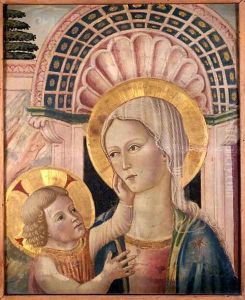Matteo da Gualdo Paintings
Matteo da Gualdo, also known as Matteo da Gualdo Cattaneo, was an Italian painter active during the Renaissance period. Born in 1435 in Gualdo Tadino, a small town in the province of Perugia in central Italy, Matteo was a prominent figure in the Umbrian school of painting, which was also represented by artists such as Pietro Perugino and Pinturicchio.
Matteo's work is characterized by its vivid color palette and a strong influence of the Gothic tradition, which was still prominent in Umbrian art during the early Renaissance. His style, however, also incorporated the evolving Renaissance ideals of perspective and the study of light, which he combined with the decorative and narrative qualities of the earlier medieval tradition.
Throughout his career, Matteo was primarily a fresco painter, and he completed numerous commissions for local churches and confraternities. One of his most significant works is the fresco cycle in the church of San Francesco in his hometown of Gualdo Tadino, which depicts scenes from the life of Saint Francis of Assisi. He was also known for his altarpieces and smaller devotional paintings.
Despite his regional success and the quality of his work, Matteo da Gualdo did not achieve the same level of fame as some of his contemporaries, and his works were largely confined to the area around Gualdo Tadino and Umbria. Nevertheless, he played a crucial role in the transmission of artistic ideas between the Gothic and Renaissance periods in this part of Italy.
Matteo da Gualdo passed away in 1507, leaving behind a body of work that continues to be appreciated for its contribution to the development of Renaissance art in Umbria. His legacy is preserved in the churches and museums of the region, where his frescoes and paintings remain on display to the public.
